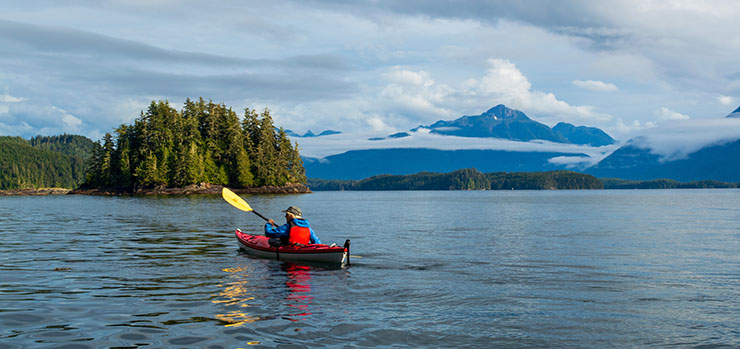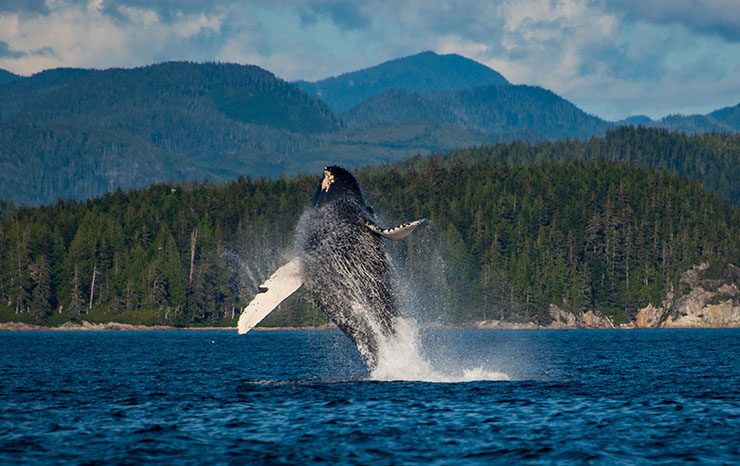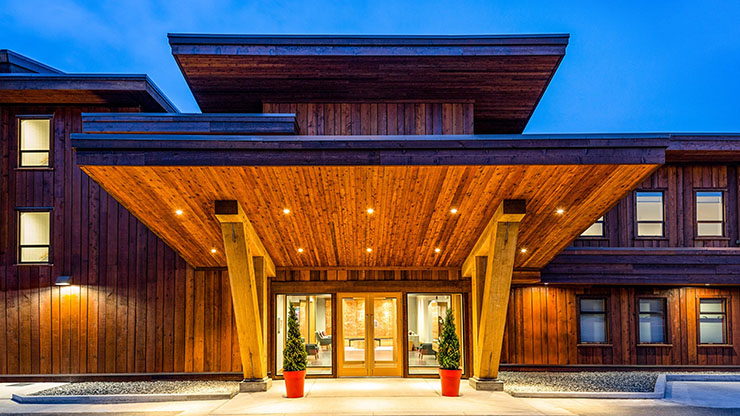Kayaking Northern Vancouver Island

WORDS Linda Doctoroff X PHOTOGRAPHY Tom Perry
Swoosh…dip, swoosh…dip, swoosh…dip and smack! Less than 50 metres from our kayaks, the humpback’s fluke whacks the water as it dives deep searching for krill.
Last summer, I left the isolating effects of these strange pandemic times to embrace another form of isolation: to seek solace in nature and to lose myself in a remote marine environment. I signed up with Orca Dreams to kayak in a marine wilderness area near the Broughton Archipelago, nestled between Vancouver Island and the BC mainland. I decided to travel solo on this trip. I often prefer it that way. I’m more open to meeting others and experiencing nature.
Base camp is a half-hour boat ride from Telegraph Cove. While waiting for the water taxi, I read about the 1918 Spanish flu pandemic that hit this tiny outpost. An eerie feeling echoes through me: 100 years later, we are living with the COVID-19 pandemic.

As we leave this historic village, we spot a pod of resident orcas about 200 metres from us. JD, the owner of the company, cuts the motor.
“There’s A23 and A25,” he says. “They’ve been active in this area lately, hungry for salmon.”
He drops a hydrophone in the ocean; we listen to the orcas sing underwater. They are skilled communicators, making sounds for orientation, navigation and feeding.
As the boat approaches our base camp, I am struck by the haunting beauty of the wilderness. A thick forest of western red cedar, Sitka spruce and hemlock covers the island. The treetops sway gently in the wind as if they are welcoming us with a slow dance. I am humbled by the natural beauty and the history of the area.
The campsite is located on small Compton Island, on Mamalilikulla-QweʼQwaʼSotʼEm Band First Nation territory. They have given permission to the company to use their land. We step off the boat onto the midden beach. I imagine how, for thousands of years, Indigenous people have lived here, fishing, farming clams and hunting. The shells are the remains of their cultural heritage and their present-day life.
The first morning, after a hearty breakfast of buckwheat pancakes, fresh fruit and bacon, we set out in our kayaks to Blackfish Sound, a wide channel known for feeding humpback whales. Humpbacks migrate annually, moving from their summer feeding grounds in the high latitudes to warmer winter breeding waters closer to the equator.
Perched high on a bare branch in the thickly treed shoreline, a bald eagle surveys the scene. It’s watching a seal feast on a salmon, patiently waiting to swoop down and scavenge any leftovers. I continue paddling and soon a sea lion joins me, swimming a few metres away. I keep pace with it until it dips down into the ocean. I paddle to the middle of the sound and pause to watch two humpbacks. They are circling around me, dipping, blowing and slapping their flukes before diving down. Am I intruding on their space?
When I return to the campsite, dinner is almost ready. Amy, our cook, sure knows her way around a kitchen. She has prepared pickled bull kelp, which she harvested that morning in the inlet. We nibble on the bright mustard-coloured delicacy while she puts the finishing touches on dinner. She is preparing pierogies from scratch, a recipe passed down from her husband’s grandmother, who came from the Ukraine. Grandma made sure Amy was married before turning over her recipe. I bite into the potato–cheddar cheese pierogi, topped with fried onions and a dollop of sour cream; I’m in heaven.
The next morning, we go out on Tenzing, a 38-year-old former US Navy whaleboat, and watch a pod of Dall’s porpoise skim along the shoreline, bobbing up and down in perfect single formation, like large bubbles dribbling.
“They are the fastest cetacean on the planet, swimming up to 56 kilometres per hour,” JD offers.
Another day, I see a purple sea star (or starfish) spread out on a barnacled rock on the shoreline. It’s good to see they are returning after several years’ absence, owing to the sea star wasting disease.
“Forty species of sea stars have been affected by this disease,” JD says, as we glide by. We stop at a small island, and, from our kayaks, we pick sea asparagus that later appears in our salad at dinner that night.
One late, starless evening, we stand on the midden beach and throw stones in the water. We watch the bioluminescence—light generated chemically by organisms—as we swish sticks back and forth in the ocean. It’s as if fireflies are swimming underwater.
Another evening after dinner, we hike the kilometre-long trail to Sunset Beach, stopping along the way to pick ripe huckleberries. I arrive just in time to catch the sun blanketing across a billowy, cloudy sky as it dips into the ocean, forming a pattern of shooting rays of gold. An orange glow covers the sea. When we return to camp, JD has just caught a 24-pound Chinook salmon.
“They like to bite in the early evening,” he says, as he’s filleting the fish on the beach, and then preparing it in brine to be smoked the next day.
On our last day, the sun shining, we head north on Tenzing. JD’s pulling a double kayak at the stern of the boat. Tom, our kayaking guide, and I are dropped off in the heart of Broughton Archipelago Marine Park to kayak back to our campsite. As we approach Blackfish Sound, there’s action ahead.
Tom excitedly says, “I’ve been here seven weeks and haven’t seen anything like this!” He quickly grabs his camera and starts taking photos. “I won’t have another chance like this,” he exclaims.
Over the UHF radio, we hear the crackling voice of a captain in another boat shout, “This is craziness!”
We see several humpbacks blowing and gliding along the ocean, while a pod of surfing orcas and dolphins cavort between them in the shimmering water. This time the humpbacks are making different sounds from what we’ve heard before. Their sounds are coming from deep within them, almost moaning, making an eerie-sounding howl. As we leave the scene and return to camp, a flock of red-necked phalaropes skim just above the water’s surface.
I went on this kayaking trip to lose myself in nature during these strange pandemic times; I wanted to be in the richness of a remote marine environment. But I came away with much more: I gained a new appreciation for the wildlife so abundant in this area.
Indeed, it was a great getaway during a pandemic.
Getting there
Flying: Fly to Port Hardy on Vancouver Island and take a taxi to Telegraph Cove.
Driving: Take Hwy 19 north
on Vancouver Island to Telegraph Cove.

eat. sleep. do. see.
The north end of Vancouver Island reveals itself as a wild and wonderful wilderness playground. It’s a place to discover tiny townsites like Coal Harbour and Zeballos, a chance to escape to sublime spots like San Josef Bay—recently named “best wilderness beach” in Canada by Lonely Planet—and to revel in nature in all its forms.
It’s the gateway to the North Coast Trail, a 43-kilometre wilderness hiking area that traverses Cape Scott Provincial Park. It’s a place to experience wildlife tours on land, sea and even from the air; explore neighbouring islands, where you’ll find charming communities like Alert Bay and Sointula and to visit the historic boardwalk community of Telegraph Cove.
Northern Vancouver Island is also a place to discover First Nations art and culture, and a stay at Kwa’lilas Hotel, owned and operated by the Gwa’sala-‘Nakwaxda’xw people, is a good place to start.
Located at the entranceway to Port Hardy—the area’s largest community at the very tip of Vancouver Island— Kwa’lilas Hotel is a premier First Nations destination. It offers 85 guest rooms—each beautifully decorated with Indigenous art and details. It’s also home to the nax’id’ Pub and a curated selection of cultural experiences.
Kwa’lilas is a kwak’wala word used by Gwa’sala-‘Nakwaxda’xw people, and it means “a place to sleep.” The visually striking structure, built by the Gwa’sala-‘Nakwaxda’xw-owned k’awat’si Construction Company, makes extensive use of local cedar, and the design is meant to resemble a traditional big house with a smoke hole at the top of the building. Traditionally, when visitors see smoke coming from a big house, it means, “welcome.”
Items found on the menu at nax’id’ Pub feature dishes inspired by First Nations cuisine, while local Indigenous art can be found in the gift boutique, lobby and throughout the hotel.
The hotel also offers a number of Indigenous experiences, including wildlife and cultural tours, and activities such as drum-making and cedar-weaving.
Port Hardy has a wealth of beaches and hiking opportunities, including the easily accessible Carrot/Rotary Park, which is a waterfront walkway that offers more than a quarter mile of promenade space. The Harbour Walkway & Nature Trail links Port Hardy neighbourhoods to the many outdoor recreation areas. It’s a paved route for both walkers and cyclists that extends from the Glen Lyon River towards the Quatse River and Estuary Trails. There’s also the Fort Rupert Trail, the Quatse River Nature Trail and Storey’s Beach, which seemingly goes on forever, when the tide is out.

 A place to tell stories
A place to tell stories